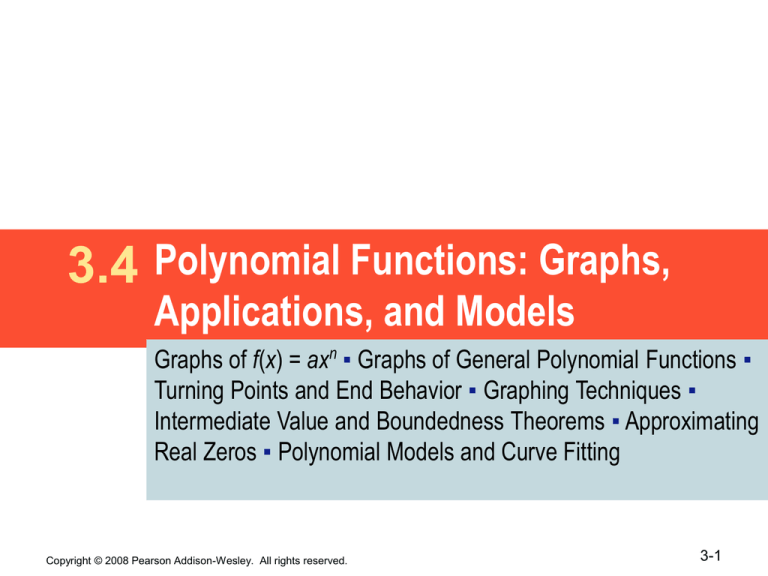
3.4 Polynomial Functions: Graphs,
Applications, and Models
Graphs of f(x) = axn ▪ Graphs of General Polynomial Functions ▪
Turning Points and End Behavior ▪ Graphing Techniques ▪
Intermediate Value and Boundedness Theorems ▪ Approximating
Real Zeros ▪ Polynomial Models and Curve Fitting
Copyright © 2008 Pearson Addison-Wesley. All rights reserved.
3-1
3.4
Example 1(a) Graphing Functions of the Form f(x) = axn
(a = 1) (page 340)
Graph
Choose several values for x, and find the corresponding
values of f(x), g(x), and h(x).
Copyright © 2008 Pearson Addison-Wesley. All rights reserved.
3-2
3.4
Example 1(a) Graphing Functions of the Form f(x) = axn
(a = 1) (cont.)
Plot the ordered pairs, and connect the points with a
smooth curve.
Copyright © 2008 Pearson Addison-Wesley. All rights reserved.
3-3
3.4
Example 1(b) Graphing Functions of the Form f(x) = axn
(a = 1) (page 340)
Graph
Choose several values for x, and find the corresponding
values of f(x), g(x), and h(x).
Copyright © 2008 Pearson Addison-Wesley. All rights reserved.
3-4
3.4
Example 1(b) Graphing Functions of the Form f(x) = axn
(a = 1) (cont.)
Plot the ordered pairs, and connect the points with a
smooth curve.
Copyright © 2008 Pearson Addison-Wesley. All rights reserved.
3-5
3.4
Example 2(a) Examining Vertical and Horizontal
Translations (page 341)
Graph
The graph of
is
the same as the graph of
, but translated 1 unit
up. It includes the points
(–1, 0), (0, 1), and (1, 2).
Copyright © 2008 Pearson Addison-Wesley. All rights reserved.
3-6
3.4
Example 2(b) Examining Vertical and Horizontal
Translations (page 341)
Graph
The graph of
is
the same as the graph of
, but translated 2
units right. It includes the
points (1, –1), (2, 0), and
(3, 1).
Copyright © 2008 Pearson Addison-Wesley. All rights reserved.
3-7
3.4
Example 2(c) Examining Vertical and Horizontal
Translations (page 341)
Graph
The graph of
is the same as the graph of
, but translated 3 units
left, reflected across the x-axis,
stretched vertically by a factor
of ½, and then translated 5
units up. It includes the points
(–2, 1.5), (–3, 2), and
(–4, 1.5).
Copyright © 2008 Pearson Addison-Wesley. All rights reserved.
3-8
3.4
Example 3 Determining End Behavior Given The
Defining Polynomial (page 344)
Use the symbols for end behavior to describe the
end behavior of the graph of each function.
(a)
Since a = −1 < 0 and f has even degree, the end
behavior is shaped
(b)
Since a = 1 > 0 and g has odd degree, the end
behavior is shaped
Copyright © 2008 Pearson Addison-Wesley. All rights reserved.
3-9
3.4
Example 3 Determining End Behavior Given The
Defining Polynomial (cont.)
(c)
Since a = −1 < 0 and h has odd degree, the end
behavior is shaped
(d)
Since a = 1 > 0 and f has even degree, the end
behavior is shaped
Copyright © 2008 Pearson Addison-Wesley. All rights reserved.
3-10
3.4
Example 4 Graphing a Polynomial Function (page 345)
Graph
Step 1: p must be a factor of a0 = –6 and q must be a
factor of a3 = 2. Thus, p can be 1, 2, 3, 6,
and q can be 1 or 2. The possible rational
zeros, , are 1, 2, 3, 6,
or
. The
remainder theorem shows that 2 is a zero.
Copyright © 2008 Pearson Addison-Wesley. All rights reserved.
3-11
3.4
Example 4 Graphing a Polynomial Function (cont.)
Setting each factor equal to zero gives the zeros of f
as 2,
, and –3.
Step 2: f(0) = –6, so plot (0, –6).
Step 3: The x-intercepts divide the x-axis into four
intervals. Select an x-value in each interval
and substitute it into the equation to determine
whether the values of the function are positive
or negative in that interval.
Copyright © 2008 Pearson Addison-Wesley. All rights reserved.
3-12
3.4
Example 4 Graphing a Polynomial Function (cont.)
Plot the x-intercepts, y-intercept, and test
points with a smooth curve to obtain the graph.
Copyright © 2008 Pearson Addison-Wesley. All rights reserved.
3-13
3.4
Example 4 Graphing a Polynomial Function (cont.)
Copyright © 2008 Pearson Addison-Wesley. All rights reserved.
3-14
3.4
Example 5 Locating a Zero (page 346)
Use synthetic division and a graph to show that
has a real zero between 1
and 2.
Use synthetic division to find f(1) and f(2).
f(1) = 2
f(2) = –3
By the Intermediate Value Theorem, there is a
real zero between 1 and 2.
Copyright © 2008 Pearson Addison-Wesley. All rights reserved.
3-15
3.4
Example 5 Locating a Zero (cont.)
Copyright © 2008 Pearson Addison-Wesley. All rights reserved.
3-16
3.4
Example 6(a) Using the Boundedness Theorem (page 348)
Show that
greater than 1.
has no real zero
f(x) has real coefficients and the leading coefficient, 1, is
positive, so the Boundedness Theorem applies. Divide
f(x) synthetically by x – 1.
Since 1 > 0 and all the numbers in the last row of the
synthetic division are nonnegative, f(x) has no real zeros
greater than 1.
Copyright © 2008 Pearson Addison-Wesley. All rights reserved.
3-17
3.4
Example 6(b) Using the Boundedness Theorem (page 348)
Show that
less than –2.
has no real zero
f(x) has real coefficients and the leading coefficient, 1, is
positive, so the Boundedness Theorem applies. Divide
f(x) synthetically by x + 2.
Since –2 < 0 and the numbers in the last row of the
synthetic division alternate in sign, f(x) has no real zeros
less than –2.
Copyright © 2008 Pearson Addison-Wesley. All rights reserved.
3-18
3.4
Example 7 Approximating Real Zeros of a Polynomial
Function (page 349)
Approximate the real zeros of
The greatest degree term is
have end behavior similar to
, so the graph will
.
There are at most 3 real zeros.
f(0) = 10, so the y-intercept is 10.
Copyright © 2008 Pearson Addison-Wesley. All rights reserved.
3-19
3.4
Example 7 Approximating Real Zeros of a Polynomial
Function (cont.)
The graph shows that there are 3 real zeros.
Copyright © 2008 Pearson Addison-Wesley. All rights reserved.
3-20
3.4
Example 7 Approximating Real Zeros of a Polynomial
Function (cont.)
There are sign changes between –9 and –8,
–1 and 0, and 1 and 2, thus the zeros are between
–9 and –8, –1 and 0, and 1 and 2.
Copyright © 2008 Pearson Addison-Wesley. All rights reserved.
3-21
3.4
Example 7 Approximating Real Zeros of a Polynomial
Function (cont.)
The zeros are approximately –8.33594, –.9401088,
and 1.2760488.
Copyright © 2008 Pearson Addison-Wesley. All rights reserved.
3-22
3.4
Example 8(a) Examining a Polynomial Model for Debit
Card Use (page 350)
The table shows
the number of
transactions, in
millions, by users of
bank debit cards.
Using the data in the table, with x = 0 representing 1990,
x = 5 representing 1995, etc., use the regression feature
of a calculator to determine the quadratic function that
best fits the data. Plot the data and the graph.
Copyright © 2008 Pearson Addison-Wesley. All rights reserved.
3-23
3.4
Example 8(a) Examining a Polynomial Model for Debit
Card Use (page 350)
The best fitting quadratic function for the data is
Copyright © 2008 Pearson Addison-Wesley. All rights reserved.
3-24
3.4
Example 8(b) Examining a Polynomial Model for Debit
Card Use (page 350)
Repeat part (a) for a cubic function.
The best fitting cubic function for the data is
Copyright © 2008 Pearson Addison-Wesley. All rights reserved.
3-25
3.4
Example 8(c) Examining a Polynomial Model for Debit
Card Use (page 350)
Repeat part (a) for a quartic function.
The best fitting quartic function for the data is
Copyright © 2008 Pearson Addison-Wesley. All rights reserved.
3-26
3.4
Example 8(d) Examining a Polynomial Model for Debit
Card Use (page 350)
Compare R2, the square of the correlation coefficient,
for the three functions to decide which function best
fits the data.
Quadratic:
Cubic:
Quartic:
The quartic value is closest to 1, so the quartic
function is the best fit.
Copyright © 2008 Pearson Addison-Wesley. All rights reserved.
3-27







